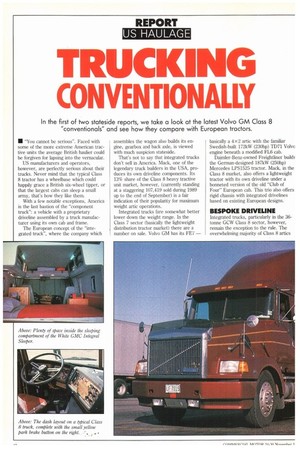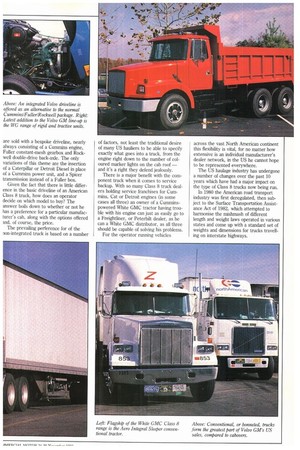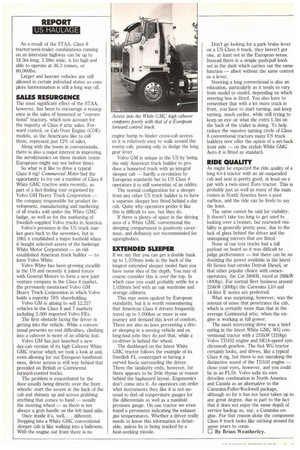TRUCKING
Page 32

Page 33

Page 34

If you've noticed an error in this article please click here to report it so we can fix it.
CONVENTIONALLY
In the first of two stateside reports, we take a look at the latest Volvo GM Class 8 "conventionals" and see how they compare with European tractors.
• "You cannot be serious". Faced with some of the more extreme American tractive units the average British haulier could be forgiven for lapsing into the vernacular.
US manufacturers and operators, however, are perfectly serious about their trucks. Never mind that the typical Class 8 tractor has a wheelbase which could happily grace a British six-wheel tipper, or that the largest cabs can sleep a small army, that's how they like them.
With a few notable exceptions, America is the last bastion of the "component truck": a vehicle with a proprietary driveline assembled by a truck manufacturer using its own cab and frame.
The European concept of the "integrated truck", where the company which assembles the wagon also builds its engine, gearbox and back axle, is viewed with much suspicion stateside.
That's not to say that integrated trucks don't sell in America. Mack, one of the legendary truck builders in the USA, produces its own driveline components. Its 13% share of the Class 8 heavy tractive unit market, however, (currently standing at a staggering 107,419 sold during 1989 up to the end of September) is a fair indication of their popularity for maximum weight artic operations.
Integrated trucks fare somewhat better lower down the weight range. In the Class 7 sector (basically the lightweight distribution tractor market) there are a number on sale. Volvo GM has its FE? —
basically a 4 x 2 artic with the familiar Swedish-built 172kW (230hp) TD71 Volvo engine beneath a modified FL6 cab.
Daimler-Benz-owned Freightliner builds the German-designed 187kW (250hp) Mercedes LPS1525 tractor. Mack, in the Class 8 market, also offers a lightweight tractor with its own driveline under a bonneted version of the old "Club of Four" European cab. This trio also offers rigid chassis with integrated drivelines based on existing European designs.
BESPOKE DRWELINE Integrated trucks, particularly in the 36tonne GCW Class 8 sector, however, remain the exception to the rule. The overwhelming majority of Class 8 artics
are sold with a bespoke driveline, nearly always consisting of a Cummins engine, Fuller constant-mesh gearbox and Rockwell double-drive back-axle. The only variations of this theme are the insertion of a Caterpillar or Detroit Diesel in place of a Cummins power unit, and a Spicer transmission instead of a Fuller box.
Given the fact that there is little difference in the basic driveline of an American Class 8 truck, how does an operator decide on which model to buy? The answer boils down to whether or not he has a preference for a particular manufacturer's cab, along with the options offered and, of course, the price.
The prevailing perference for of the aon-integrated truck is based on a number of factors, not least the traditional desire of many US hauliers to be able to specify exactly what goes into a truck, from the engine right down to the number of coloured marker lights on the cab roof — and it's a right they defend jealously.
There is a major benefit with the component truck when it comes to service backup. With so many Class 8 truck dealers holding service franchises for Cummins, Cat or Detroit engines (in some cases all three) an owner of a Cumminspowered White GMC tractor having trouble with his engine can just as easily go to a Freightliner, or Peterbilt dealer, as he can a White GMC distributor, as all three should be capable of solving his problems.
For the operator running vehicles across the vast North American continent this flexibility is vital, for no matter how extensive is an individual manufacturer's dealer network, in the US he cannot hope to be represented everywhere.
The US haulage industry has undergone a number of changes over the past 10 years which have had a major impact on the type of Class 8 trucks now being run.
In 1980 the American road transport industry was first deregulated, then subject to the Surface Transportation Assistance Act of 1982, which attempted to harmonise the mishmash of different length and weight laws operated in various states and come up with a standard set of weights and dimensions for trucks travelling on interstate highways. As a result of the STAA, Class 8 tractor/semi-trailer combinations running on an interstate highway can be up to 18.3m long, 2.59m wide, 4.1m high and able to operate at 36.3 tonnes, or 80,000Ibs.
Larger and heavier vehicles are still allowed in certain individual states so complete harmonisation is still a long way off.
SALES RESURGENCE
The most significant effect of the STAA, however, has been to encourage a resurgence in the sales of bonneted or "conventional" tractors, which now account for the majority of Class 8 artic sales. Forward control, or Cab Over Engine (COE) models, as the Americans like to call them, represent just 12% of sales.
Along with the boom in conventionals, there is also a major interest in improving the aerodynamics on these models (some Europeans might say not before time).
So what is it like to drive a typical Class 8 rig? Commercial Motor had the opportunity to try out a number of Class 8 White GMC tractive units recently, as part of a fact-finding tour organised by Volvo GM Heavy Truck Corporation — the company responsible for product development, manufacturing and marketing of all trucks sold under the White GMC badge, as well as for the marketing of Swedish-supplied Volvo trucks in America.
Volvo's presence in the US truck market goes back to the seventies, but in 1981 it established a major foothold when it bought selected assets of the bankrupt White Motor Corporation — an oldestablished American truck builder — to form Volvo White.
Volvo White has been growing steadily in the US and recently it joined forces with General Motors to form a new joint venture company in the Class 8 market, the previously mentioned Volvo GM Heavy Truck Corporation in which Volvo holds a majority 76% shareholding.
Volvo GM is aiming to sell 12,227 vehicles in the Class 8 and 7 markets including 2,000 imported Volvo FEs.
The first obstacle facing the driver is getting into the vehicle. While a conventional presents no real difficulties, climbing into a cabover is more of an athletic feat.
Volvo GM has just launched a new day-cab version of its high Cabover White GMC tractor which we took a look at and, even allowing for our European hamfistedness, driver access is still way behind that provided on British or Continental forward-control trucks.
The problem is exacerbated by the door usually being directly over the front wheels: start the ascent at the back of the cab and shimmy up and across grabbing anything that comes to hand — usually the steering wheel — as there is not always a grab handle on the left hand side.
Once inside it's, well. . . different. Stepping into a White GMC conventional sleeper cab is like walking into a ballroom. With the engine out front there is no engine hump to hinder cross-cab access so it is relatively easy to walk around the roomy cab, pausing only to dodge the long gear lever.
Volvo GM is unique in the US by being the only American truck builder to produce a bonneted truck with an integral sleeper cab — hardly a revolution by European standards but to US Class 8 operators it is still somewhat of an oddity.
The normal configuration for a sleeper from any other US truck builder is to have a separate sleeper box fitted behind a day cab. Quite why operators prefer it like this is difficult to see, but they do.
If there is plenty of space in the driving area of a White GMC conventional the sleeping compartment is positively cavernous, and definitely not recommended for agoraphobics.
EXTENDED SLEEPER
If we say that you can get a double bunk up to 1,370mm wide in the back of the longest extended sleeper model then you have some idea of the depth. You may of course consider this is over the top. In which case you could probably settle for a 1,020mm bed with an oak wardrobe and storage cabinets.
This may seem opulent by European standards, but it is worth remembering that American Class 8 drivers frequently travel up to 1,000Icm or more in one journey and demand this level of comfort. There are also no laws preventing a driver sleeping in a moving vehicle and on long-haul jobs they do just that, while a co-driver is behind the wheel.
The dashboard on the latest White GMC tractor follows the example of its Swedish FL counterpart in having a curved fascia surrounding the driver. There the similarity ends, however, for there appears to be little rhyme or reason behind the haphazard layout. Ergonomics don't come into it. As operators can order what instruments they like it is not unusual to find oil temperature gauges for the differentials as well as a manifold pressure gauge. On one tractor we even found a pyrometer indicating the exhaust gas temperatures. Whether a driver really needs to know this information is debatable, unless he is being tracked by a heat-seeking missile. Don't go looking for a park brake lever on a US Class 8 truck, they haven't got one, at least not in the European sense. Instead there is a simple push/pull knob set in the dash which carries out the same function — albeit without the same control as a lever.
Steering a long conventional is also an education, particularly as it tends to vary from model to model, depending on which steering box is fitted. You also have to remember that with a lot more truck in front, you have to start turning, and keep turning, much earlier, while still trying to keep an eye on what the extra 1.5m on the back of the trailer is doing. To help reduce the massive turning circle of Class 8 conventional tractors many US truck builders now offer the option of a set-back front axle — on the stylish White GMC Aero it is fitted as standard.
RIDE QUALITY
As might be expected the ride quality of a long 6.x4 tractor with an air-suspended cab and seat is pretty good, at least on a par with a twin-steer Euro tractor. This is probably just as well as many of the main routes in North America have a poor surface, and the ride can be lively to say the least.
The same cannot be said for visibility. It doesn't take too long to get used to looking over a bonnet, but rearward visibility is generally pretty poor, due to the lack of glass behind the driver and the uninspiring mirrors that are fitted.
None of our test trucks had a full payload on board so it was difficult to judge performance — but there can be no doubting the power available in the latest 60 Series four-stroke Detroit Diesel, or that other popular choice with owneroperators, the Cat 3406B, rated at 298kW (400hp). For normal fleet business around 224kW (300hp) the Cummins L10 and 14-litre E series are preferred.
What was surprising, however, was the amount of noise that penetrates the cab, which is certainly more than that in the average Continental artic, when the engine is working at full power.
The most interesting drive was a brief outing in the latest White GMC WG conventional tractor with a 231kW (310hp) Volvo TD102 engine and SR14-speed synchromesh gearbox. The 6x4 WG tractor certainly looks, and drives, like a typical Class 8 rig, but there is not mistaking the distinctive sound of the TD102 engine — close your eyes, however, and you could be in an ELIO. Volvo sells its own driveline combination in North America and Canada as an alternative to the Cummins/Fuller/Rockwell package, although so far it has not been taken up to any great degree, due in part to the fact that it does not enjoy the same depth of service backup as, say, a Cummins engine. For that reason alone the component Class 8 truck looks like sticking around for some years to come.
By Brian Weatherley.










































































































